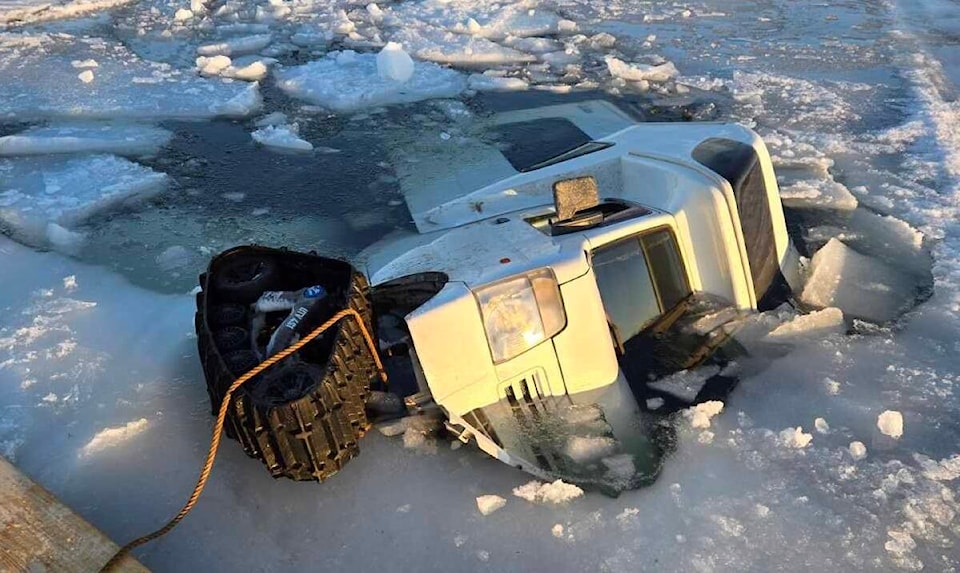The NWT’s frozen bodies of water are rapidly melting as spring takes hold.
While that may be good news for residents waiting to get their boats in the water, the thaw also presents serious risk. For example, look no farther than Mosher Island, a small island southeast of Yellowknife, where two vehicles plunged into frigid waters after their drivers attempted to traverse the thinning ice during the April 20-21 weekend.
The drivers and passengers of the two vehicles — a snowmobile and a Suzuki side-by-side with an added camper component — emerged from the incident unscathed, according to witness Jeremy MacDonald. However, both vehicles had to be hauled from the water, and are now drying out in a nearby shop. Things certainly could have ended up much worse than that.
“A sudden fall into cold water can result in cold-water shock,” said Madison Lalonde, the director of communications and public education at the Lifesaving Society of Alberta and the Northwest Territories, an organization that aims to prevent water-related injury in both regions.
“Our breathing, muscle strength, coordination and overall decision-making are greatly affected by cold water, making drowning more likely for even the strongest of swimmers,” she said. “It is recommended to stop using ice once spring thaws begin. Even if ice measures at the right thickness, consistent thawing and refreezing of ice weakens the ice vertically and it can no longer be trusted.
“Even ice sections that are very close together can have very different thicknesses.”
Great care should always be taken by anybody who is considering venturing out onto a frozen body of water.
“Always avoid ice over moving water or fluctuating water levels,” said Lalonde. “Beware of snow buildup. Snow acts like an insulating blanket. Ice under the snow will be thinner and weaker.”
One of the most important things for anybody who goes out onto the ice, she emphasized, is to “never go on ice alone.”
“A buddy may be able to assist you or get help if you are in trouble,” she said.
It is also important to ensure you are carrying the necessary supplies, including a lifejacket, which can be “worn over your snowmobile suit or layered winter clothes to increase your survival chances if you do go through the ice.”
She also recommends carrying ice picks, an ice staff, rope, and a small personal safety kit. The safety kit should include items like a lighter, waterproof matches, a magnesium fire starter, a pocketknife, a compass, a whistle and a cellphone,” she advised.
If disaster strikes and you fall through ice, Lalonde said it’s important not to panic, to “get as much of your body out of the water as you can,” and to call for help immediately.
She also emphasized the importance of the “1:10:1” rule, which can be summarized as follows:
Begin by taking one minute to get your breathing under control. “This is how long it takes for your body to overcome the initial shock — try to float or lightly tread and keep your head above water,” she said.
Next, attempt 10 minutes of “meaningful movement” towards shore or a boat.
“After 10 minutes, your strength and dexterity are greatly reduced,” she said.
Finally, recognize that after one hour, you may become “unconscious due to hypothermia.”
If you are travelling with somebody else, and they fall through the ice, Lalonde said you should not attempt to rescue them yourself, as you may also end up in the water.
“Call 911, verbally encourage [the person in the water] to clam down and focus on their breathing,” she said. “If it is safe, without putting yourself at risk, you can assist them with a throwing or reaching assist, like a lifejacket or a rope.
“If they are able to get out of the water, assist them in removing wet clothing and treat them for hypothermia.”
Above all, Lalonde said, it’s important to remember that “ice is never 100 per cent safe,” whether it’s in the fall, winter, or spring, so precautions should always be taken.
